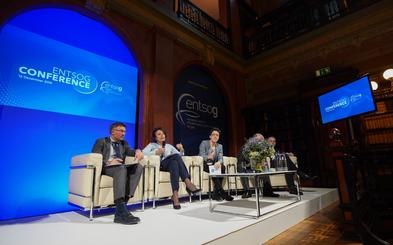Energy Transition
ENTSOG facilitates gas grids’ constructive role in the energy transition, including the repurposing of the gas grids for the transport of renewable and low carbon gases. The necessary activities will be undertaken, as required by Directive (EU) 2024/1788 and Regulation (EU) 2024/1789 (Hydrogen and Decarbonised Gas Markets package). This legislation aims to decarbonise gas markets, promote hydrogen and biomethane integration in the gas infrastructure and reduce methane emissions.
ENTSOG will continue dialogue with relevant stakeholders from the hydrogen, electricity, CO2 and natural gas value chains, as well as storage and LNG system and ports operators, DSOs and hard-to-decarbonise off-takers, among others.
ENTSOG will continue to engage with stakeholders in the following fora:
- Advisory Panel for Future Gas Grids
- Prime Mover Group on Gas Quality and Hydrogen Handling
- Prime Mover Group on Guarantees of Origin
- European Clean Hydrogen Alliance Roundtable on Clean Hydrogen Transmission and Distribution
- Industrial Carbon Management (ICM) Working Groups
For further information please contact:
Roberto Francia - Regulatory Affairs Manager
ENTSOG Conference 12 December 2018
Interviews with stakeholders
Hear from our key stakeholders at ENTSOG's Conference on 'Gas Infrastructure on Sustainable Economy'.
- Andris Piebalgs, Florence School of Regulation
- Bart Biebuyck, Fuel Cells and Hydrogen Joint Undertaking
- Beate Raabe, Eurogas
- Giles Dickson, WindEurope
- Marion Labatut, Eurelectric
- Bartek Gurba, DG ENER, European Commission

Gasunie
Moving towards 2030 and 2050 with hydrogen
Moving towards 2030 and 2050 with hydrogen in the North of the Netherlands!
ENTSOG
ENTSOG 2nd Annual Conference, 12 December 2018
Focusing on gas innovation, decarbonisation and the coupling of gas and electricity systems, ENTSOG Members (Transmission System Operators – TSOs) presented four innovative projects. These can be found on ENTSOG’s newly updated website called ‘Innovative Projects Platform’. The conference outcomes from the event support some of the conclusions of the last 31st Madrid Forum and ENTSOG sees these ideas as an important part of the potential gas legislation review in 2020.
Head of Market Change, National Grid
Nicola Pitts
TSO's perspective: Nicola Pitts talks about the future role of gas infrastructure.
ENTSOG / ENTSOE
Power to Gas – A Sector Coupling Perspective
To date, the electricity transmission grid and currently available technologies efficiently integrated renewable sources of electricity into the power system. The ongoing energy transition will require additional developments. Power to Gas – and other P2X (e.g. Power to Liquid, Power to Heat) may have the potential to reduce the cost of the decarbonised energy system in particular when the end consumption is either gas or other high value energy forms.
ENTSOG
Decarbonising through gas networks – A TSO perspective
This topic was presented by Jan Ingwersen at the Madrid Forum on 16 October 2018. The 2020 Gas Package will pave the way for achieving the sustainability goals for gas as well as for electricity/gas interaction –and at the same time continue pursuing the goals on gas markets and security of supply. ENTSOG’s five themes for the Gas Package 2020 are presented in this slide package
ENTSOG
How to spend it: Future business models for European gas
This topic was presented by Jan Ingwersen at the GIE Annual Conference in Bucharest on 14 June 2018. Some key issues for the Gas Package 2020 include the need for political acceptance and support for a hybrid energy carrier system–aiming for utilization of existing assets, sector cooperation and optimisation, improved flexibility and better security of supply.


